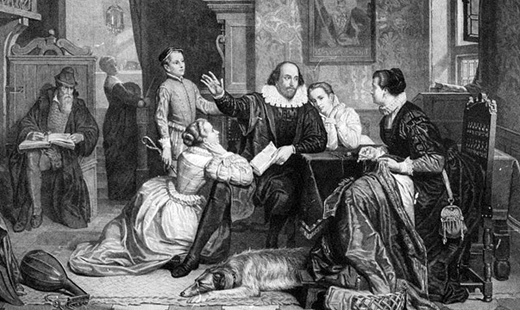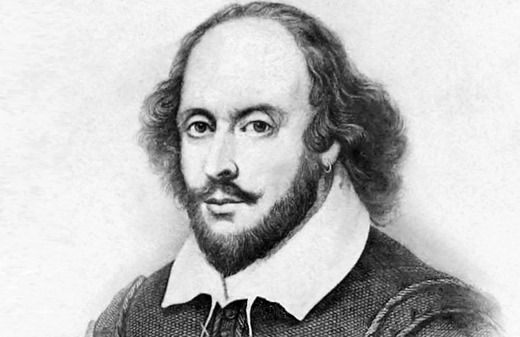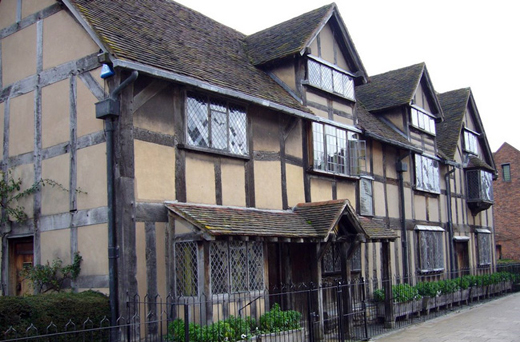Do you know what Shakespeare wrote about India?
Do you know what Shakespeare wrote about India?
mangaloretoday.com/ India Today
April 23, 2014: As the world celebrates the 450th birth anniversary of the Bard of Avon William Shakespeare today, let’s look back on how the playwright knew and wrote about India. Shakespeare lived at a time when India was ruled by Akbar the Great, or the Great Mogor as he was referred to by the sea-faring Europeans, whose long reign was marked by opulence, harmony and a resultant peace.

A German engraving dated 1890s shows William Shakespeare reciting his play Hamlet to his family. His wife, Anne Hathaway, is sitting in the chair on the right; his son Hamnet is behind him on the left; his two daughters Susanna and Judith are on the right and left of him.
There are various references to India in Shakespearean plays. He uses words like Ind, Inde, India, Indies (East) and Indian to refer to a country fabulously rich. The earliest reference to India occurs in ’King Henry VI’ (Act III, Scene I):
"My crown is in my heart, not on my head; not decked with diamonds and Indian stones, nor to be seen: my crown is called content, a crown it is that seldom kings enjoy."
The maximum number of times India has been referred to in a single play is four, in ’A Midsummer Night’s Dream’. India appears in this play as the land of gold and sunshine.
There are other references too.
Troilus, the tragic prince of Troy, who had fallen in love with Cressida says, in ’Troilus and Cressida’, ’her bed is in India, there she lies, a pearl’ (Act I, Scene I).
In another place in the same play, Pandarus who wants to bring Troilus back to him is prepared to walk barefoot to India: Condition, I had gone barefoot to India (Act I, Scene II).
In ’The Merchant of Venice’, India, which was a major centre of trade for many countries of Europe, finds a mention on more than one occasion. Protagonist Bassanio makes a reference to his friend Antonio’s trade with India: What, not one hit?/ From Tripolis, from Mexico, and England,/ From Lisbon, Barbary, and India? (Act III, Scene II)
On another occasion, Bassanio tells Antonia: Thus ornament is but the guiled shore/ To a most dangerous sea, the beauteous scarf/ Veiling an Indian beauty... (Act III, Scene II)
In Twelfth Night, Sir Toby describes Olivia’s gentlewoman Maria as ’metal of India’ (Act II, Scene V).
In All’s Well That Ends Well, Helena who is in love with Bertram whose high social status is beyond her reach mourns that her lot is like the sun-worshippers of India: Thus, Indian-like,/Religious in mine error, I adore/The sun that looks upon his worshipper/But knows of him no more.
In Othello, the protagonist regrets that he killed Desdemona without realising her virtues, like the Indian who threw away his pearl: Thus, Indian-like,/Religious in mine error, I adore/The sun that looks upon his worshipper/But knows of him no more (Act V, Scene II).
What we have to realize is the limitation of first-hand knowledge. Shakespeare was not a traveller and he lived almost all his life in Stratford-upon-Avon and London. But being in London brought him in contact with the immense tales the sailors brought from around the world.
This, coupled with his exemplary power of imagination, joined the missing dots in his mind and the bard was ready with his own picture of the distant country to be sprinkled generously all over his plays.
His India is exceptionally rich, famous for its precious pearls and stones, its people are deeply religious and its veiled women are famed for their dark beauty.

Shakespeare’s house in Stratford-upon-Avon, England. It is a major tourist destination now.
For a man with no certain education born and brought up in a remote English village 450 years ago, drawing up this picture of a distant country his people had little contact with was no mean achievement.
By 1755, i.e. less than 150 years after his death, his plays had started being enacted in Calcutta and in the next 100 years, the first translation of Shakespeare in an Indian language was ready.
References:
1. India in Shakespeare, CR Banerji (The Indian Journal of English Studies, Orient Longman, New Delhi)
2. The Glimpses of India in Shakespeare’s plays, Ravikant Malviya, Deepti Vanjare, Ashish Gupta (International Research Journal)
3. Plays of William Shakespeare.
- Surveyor, real estate agent arrested on bribery charges in Mangaluru
- H. V. Dharshan takes charge as DC of Dakshina Kannada
- Air India temporarily suspends one daily flight between Mangaluru and Dubai
- 911 houses damaged due to natural calamities in Dakshina Kannada since April: DDMA
- New FASTag : ’Rs 3,000, 200 trips...’ Central minister, Nitin Gadkari shares annual Pass details
- Deputy Commissioners transferred: Darshan HV is new DC of DK, Swaroopa T K is Udupi DC
- Mangaluru: NSUI leader among 2 killed in horrific car crash
- Bengaluru Stampede: BJP holds protest demanding CM, Dy CM resignations; police detain protesters
- Mangaluru: MLA Vedavyas Kamath inspects landslide damage at Kadri Shivabhag
- Expert PU College reaches a new milestone in excellence
- BJP to hold district-wide protest against state government on June 23: Capt Brijesh Chowta
- Mangaluru: Landslide destroys five homes in Kannur; MLA promises rebuilding
- Mangaluru: Young doctor killed as car overturns on Nanthoor–Pumpwell stretch in NH 66
- 13 Air India crashes, 1,200+ deaths: The one deadly mistake found in every tragedy
- Indian scientists establish secure quantum communication in breakthrough achievement
- Shubhanshu Shukla ready for launch: Why fighter pilots make the best astronauts
- Daughter sends mom’s ashes on epic world adventure in a bottle: "She’s travelling"
- New regenerating flatworm species ’Dugesia Punensis’ discovered in Pune
- World Environment Day 2025: 20 inspiring messages to tackle pollution and go green
- Noida road rage on camera: Thar SUV rams man after fight on Instagram
- Bengaluru man becomes thief to maintain 3 wives, 9 children, arrested: Cops
- Man clinging onto car bonnet driven for 6 km after argument at Mumbai airport
- 6 of family die inside car, 7th sitting outside said "will die in 5 mins"
- "Maa, I didn’t steal the chips": 12-year-old’s suicide note after public scolding.
- Stories of resilience and quiet revolt
- Kerala’s hidden cricket paradise: Palappilly ground’s viral beauty stuns internet
- 110 Indian students evacuated from Iran, land in Delhi
- Karnataka govt slammed for favouring Amul over Nandini
- AI crash Lone survivor discharged from hospital; attends brother’s cremation in Diu
- Kerala mountaineer stuck on Mt Denali in US, seeks help from India
- Two Air India flights cancelled; one due to unavailability of aircraft
- CM Siddaramaiah assure safe return of Kannadigas stuck in war-hit regions
- Ali Shadmani, Iran’s top commander and Khamenei aide, killed in Israeli strike
- Ahmedabad plane crash: 135 victims identified, 101 bodies handed over to kin
- Woman held in Hubballi for branding son’s limbs for being ’naughty’
- Colonel’s teary farewell in uniform to husband-pilot killed in chopper crash
- "Rule of law mandates...": Top Court on Kamal Haasan’s film’s Karnataka release
- Temple priest’s assistant from Kerala arrested for sexually assaulting woman in Bengaluru
- CITY INFORMATION
- TRAVEL
- TOURIST INFORMATION
- HEALTH CARE
- MISCELLANEOUS




 Write Comment
Write Comment E-Mail
E-Mail Facebook
Facebook Twitter
Twitter  Print
Print 


